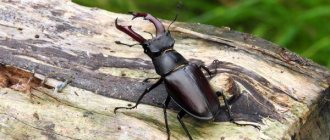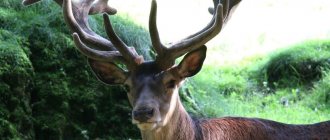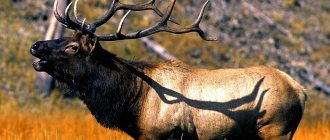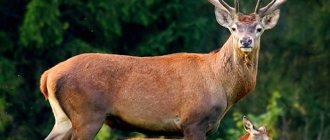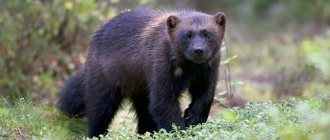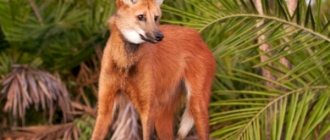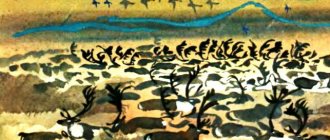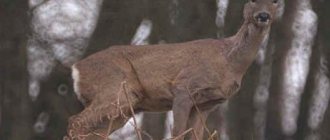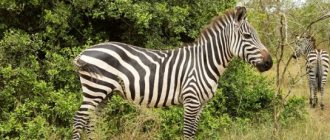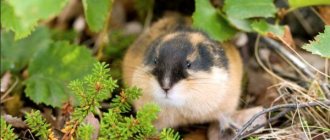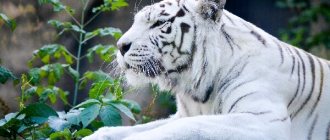Appearance
If you look at this powerful beast, the question involuntarily arises - how much does a deer weigh? To imagine this majestic creature, you need to know the description of the reindeer. This is a fairly large animal, weighing up to 200 kg, with a large torso and stocky legs. And despite this, he looks very graceful as he runs across the tundra.
The heads of males and females are crowned with branched antlers, giving the deer regal majesty. This is the main distinguishing feature of this species - the presence of horns in both males and females.
The animal’s fur is very beautiful, in places it is light gray in color, almost white. Since the hair inside is hollow and filled with air, this helps to better keep the animal on the water.
Closer to winter, a down grows in the wool, which retains heat well in severe cold weather.
To move well in the snow, the legs are equipped with wide hooves that can walk through any snowdrifts and off-road conditions. With their help, reindeer in the tundra are able to remove a layer of snow and get food for themselves in the form of moss.
Habitats
This proud animal can be found on the Kola Peninsula and Kamchatka, Western Chukotka and northern Sakhalin. Lives in North America and Canada. There is a very large population on the Taimyr Peninsula.
The harsh tundra and semi-tundra are ideal places for the life of horned beauties, where they have lived for thousands of years. So, knowing where reindeer live, if you wish, you can go and admire them in the wild.
Lifestyle
Reindeer live both on plains and in mountainous areas. They stick to the edges of forests and rivers. Avoid dense forests and large monotonous plains.
In the summer, animals move as close as possible to the Arctic coast. In other areas, midges interfere with their quiet life. The cold wind saves you from these hordes of annoying insects. In winter, reverse migration occurs.
To find food, an adult deer travels 1,500 km. Migration routes are the same in both summer and winter. These are herd animals. Lonely individuals are extremely rare. Together it is easier to find food, stay warm in severe frosts, and protect from predators. Each herd has a leader who is the first to attack enemies and protects the females from other males. One herd includes about a thousand animals, and during migration, this number increases.
Lifestyle and habits
Deer live in large herds, which makes it easier to find food and fight off enemies. In search of moss, the herd moves long distances, crossing the tundra and small rivers. Due to the structure of their body, this is not difficult for them.
In the fall, during fights for a female, the animal's horns are used in mating games between rival males. Fights between males and females are also possible. The latter may not allow a male to approach them for a long time for various reasons.
When do deer shed their antlers? Males either lose their luxurious horns during fights for the best female, or they themselves fall off after mating games. Females use them all winter, winning the best places for feeding.
Huge herds stop to feed during migration and travel up to 700 km in 1.5 months. Migration routes are almost constant, but sometimes they change due to various factors occurring in nature.
Nutrition
What do reindeer eat? Favorite delicacy is moss. This moss grows in a continuous carpet in the tundra all year round, and therefore these animals do not experience a shortage of food. Possessing a keen sense of smell, they can hear the smell of moss under a 50-centimeter layer of snow. But moss grows very slowly - only 4 mm per year, and therefore herds wander from place to place in search of it.
Lichen is a fairly nutritious plant that contains in its chemical composition a natural antibiotic that helps animals get rid of many diseases. But this is, so to speak, a winter diet. What do reindeer eat in summer?
In summer you can also eat:
- berries;
- mushrooms;
- grass;
- leaves of bushes and trees that they can reach.
To help these beauties survive the difficult winter times, people place small haystacks along the edges of the fields, which help the animals feed in the cold.
After getting acquainted with the most beautiful animal, we learned what reindeer eat in the tundra.
Reindeer: description
This artiodactyl animal is considered a unique representative of the deer family, since not only males, but also females have antlers. Reindeer are not impressive in size, but they have a variety of body colors. As a rule, this animal’s neck and chest are quite light, and the rest of the body is colored gray-brown, as well as dark brown. Adult individuals grow up to 2 meters in length, and their height at the withers is about one and a half meters, with a weight of about 200 kilograms. Reindeer living in the tundra are somewhat smaller in size, since only some individuals weigh a little more than one hundred kilograms. Regardless of whether a deer is wild or domesticated, it is almost impossible to distinguish them if you do not have the appropriate skills. They are often crossed to produce stronger and healthier offspring.
Appearance
It is not at all difficult to distinguish reindeer from other types of deer if you pay attention to their antlers. They first bend towards the body, and then towards the head.
In late spring or early summer, females shed their antlers. And males wear them until real cold weather sets in. After some time, the horns begin to grow again, but each time their shape becomes more complex due to the appearance of new processes. The five-year-old animal has the most developed horns, since at this age they become fully grown.
Interesting to know! Reindeer have excellent hearing and sense of smell, but their vision is poorly developed. Being in a herd, they are guided by the behavior of their leaders.
With the onset of severe cold weather, reindeer grow long hair, which breaks down greatly due to the peculiarities of its structure. The fact is that each hair is hollow, that is, it has emptiness inside. Thanks to this feature, deer retain their body heat better. In winter, reindeer have a different body color. As a rule, their color is almost white, although there are fragments of a dark brown tint on the body. In summer, these animals have less thick fur, especially since it is softer and shorter. In addition, body color varies from gray to brown tones. Small baby deer, as a rule, have a monotonous coloring.
Reindeer have fairly wide hooves with characteristic indentations, which allows the animals to obtain food for themselves from under the snow, which is often quite deep.
Reindeer lifestyle
Reindeer prefer to lead a herd lifestyle, and they migrate along the same route every year. The length of the route can be about 500 kilometers. The end of spring and the beginning of summer for these latitudes is characterized by the fact that there is much more food in the tundra, so deer head to these places. When they go into the tundra, this is how they escape from blood-sucking insects, which take a lot of strength and energy from the deer. When summer ends, the animals return.
Lifespan
Under natural conditions, these animals do not live long, but domesticated animals can live up to almost 28 years. Nowadays, many peoples of the north have mastered reindeer herding and only a small proportion of them continue to hunt wild animals that are of commercial interest. In this regard, we can say that the total number of reindeer changes from year to year, now in one direction, now in the other. The main influence on reindeer populations is exerted by human economic activity. Currently, there is a tendency to increase the number of these animals. According to some data from Russian experts, the number of reindeer may be about 1 million individuals.
REINDEER
Natural habitats
Reindeer mainly live in the tundra, forest-tundra, as well as on plains and in mountainous areas, common within the coniferous taiga. In addition, deer can be found in harsh open forests or swampy areas. In severe cold, these animals head south, where the taiga and forest-tundra are located. Usually the herds number several thousand individuals, but when they reach the wintering grounds they are divided into smaller groups.
With the onset of spring, the pace of migration slows down somewhat, as animals have to stop to replenish their strength and energy. In a month and a half, animals travel an average of 450 kilometers.
Important point! Reindeer living in mountainous areas do not move such significant distances. They can migrate a hundred or two kilometers, with vertical movements within the mountains being within 1000 meters.
Diet
It's not easy for reindeer, as they have to constantly find food for themselves from under a thick layer of snow. If the snow has just fallen, then deer are able to get food from a depth of one and a half meters, and if the snow has already settled, then even a 30-centimeter layer is difficult to reach. As a rule, males dig up the snow, after which they feed first. Behind them, females can feast on plant food, and lastly, fawns and weakened animals.
In order for deer to survive in winter in such difficult conditions, they have to expend quite a lot of strength and energy. In this regard, animals need enough nutritional components for this. When reindeer walk in a herd, they don't stop. If a little grass or lichen turns up on the way, the deer will grab only a small portion, leaving most of it for its relatives who are walking behind. The deer's body copes well with moss and other plant foods, assimilating it. At the same time, deer consume a fairly low percentage of young shoots and tree branches.
Despite the fact that moss is the main food of reindeer, it does not have the protein so necessary for animals. In addition to protein, moss has very little other useful components, except silicon, but the animal’s body practically does not absorb it. And yet moss for deer is a high-calorie food that can provide them with the necessary energy.
Like any living beings, deer need protein and a complex of vitamins and minerals in winter. In this regard, their body uses the reserves that deer make in the summer. Therefore, reindeer, having used up their reserves in the winter, will have to replenish their bodies with all the necessary nutrients in the summer. To do this, they eat everything that comes their way: various plant foods, mushrooms, berries, as well as salt water. In northern latitudes, summer does not last long, so animals have to prolong their migrations, staying further away in places that are still rich in nutritious food.
Interesting moment! Mushrooms are a real treat for deer. Thanks to mushrooms, they replenish their body with many nutritional components, especially at the end of summer and before the first snow falls. To feast on mushrooms, the herd may disperse, and some individuals even leave it for a while.
Moss for deer is not considered the main, but an auxiliary dish, and its role increases significantly when there is a lot of snow. Often deer eat moss by accident when they find it mixed with other food. Since deer are sometimes in dire need of vitamins and minerals, they can dilute their diet with small rodents, bird eggs and chicks.
Reindeer often eat the shed antlers of their relatives, as well as moose. They can gnaw on salt marshes, while quenching their thirst with snow, which they swallow along with food. If severe frosts appear during the period when the first snow has not yet fallen, then the deer have a very hard time.
As a rule, this fact leads to dehydration of the body and rapid loss of the thickness of the subcutaneous fat layer, which can lead to unpredictable consequences, and sometimes even to the death of the animal.
Reproduction
Sexual maturity in these animals occurs by two years, and a female reindeer can give birth to cubs up to 18 years of age.
Reproduction begins in autumn. This is adapted to ensure that the young appear during the snowmelt, 227 days after the female covers. Before this, males seek the attention of females by arranging mating games in the field of action of her eyes.
Pregnancy lasts almost 8 months, after which one small cub is born in May and immediately stands on its feet. It's rare to have two babies.
On the second day after birth, the reindeer calf already runs freely around its mother and feeds on her milk. At the age of one week, he can already swim across a small river. The appearance of horns on the fawn's head occurs in the third week of its life.
Population and species status
Today, the world population of reindeer numbers more than 15 million animals. The main factors in its decline are hunting and human economic activity (deforestation, road construction, grazing of domestic relatives).
Wild reindeer are easy prey for poachers and hunters. This has led to the fact that at present they are preserved only in remote areas where humans rarely set foot. Some species of reindeer are protected by the Red Book and are protected in nature reserves.
Return to content
Enemies in nature
In nature, this ungulate often becomes prey for predatory animals:
- wolves;
- wolverines;
- bear
During their migration journeys, sick or weakened animals are at the end of the herd and become prey for predators.
Humans can also be counted among the enemies; until recently, these animals were mercilessly exterminated for the sake of their skins and horns.
Human use
The life of northern peoples has always depended on reindeer. Domestic ones were used to transport goods, while wild ones were hunted. It was believed that the more deer heads a family had, the richer it was.
Plagues are made from the skins, and clothing is sewn for both women and men. They make warm and comfortable winter shoes.
Meat, entrails and blood are used to make food. The milk of females is also used in cooking.
Amazingly beautiful jewelry is made from horns and hooves. Horns are also used in medicine, as they have healing properties. Scientists were also interested in these medicinal properties, and they found that the powder prepared from the horns contained a remarkable gene responsible for the renewal of bone tissue. As a result, drugs were produced that could stimulate a person’s internal mental and physical reserves of strength.
How are deer used?
These animals are the main source of food for the people of the north. Gradually, people learned to receive meat and milk from them. Reindeer husbandry is very common. The skins of killed animals were used to build temporary shelters, and warm clothes were made from them. Various tools and tools were created from bone remains and horns.
After man began breeding artiodactyls, he learned to use them as a means of transportation along the northern off-road. Reindeer herders use the animal to transport goods and various materials.
Interesting Facts
Always curious to know about interesting facts about reindeer:
- Now, like many years ago, a wonderful holiday is celebrated - Reindeer Herder's Day. During the holiday, reindeer sled riding competitions are held.
- When walking, these animals make sounds that resemble knocking.
- This is the only species in which the females have horns.
Reading interesting facts about reindeer will tell a person little; you just need to see them in person, touch their warm fur, hear their breathing when they run in a sled. Otherwise they cannot be understood.
Species protection
Reindeer hunting is prohibited. Today, reindeer are listed in the Red Book as a protected species.
Nurseries have been created in the country where these animals feel relatively calm, since they are not poached.
Recently, feeding areas have been greatly reduced. A lot of industry appeared in the northern regions, in places where herds used to graze. And if we take into account that the lichen grows extremely slowly, then there was not enough food for everyone, which also greatly reduced the number of individuals.
The inclusion of the species in the Red Book was done so that the population would not decrease, but would be able to fully or at least partially restore its ranks.
What does a deer eat?
All deer belong to the category of herbivores.
Deer consume all parts of the plant as food, including branches, buds, leaves, bark, as well as grasses and moss. If we compare deer with other representatives of the bovid family, we can note that they still prefer softer plant foods.
The basis of the diet of sika deer consists of herbaceous plants, acorns that have fallen from trees, fruits and nuts, foliage of bushes and trees, berries, and mushrooms.
In winter, they also eat young branches and bark, being more active during the daytime. In summer they prefer to eat at dawn and at dawn.
Red deer feed very variedly - any gifts of nature. Not only soft grassy vegetation suits them quite well, but also “coarser” food, which includes cereals and legumes, tree leaves that have fallen in the fall, any stems, berries, fruits, lichen, mushrooms, nuts, chestnuts, acorns, spruce and pine needles, shrub bark.
They also eagerly lick salt, replenishing its lack in the body. In the hot summer, they try not to feed, but only lie quietly in the shade. They go out to pasture early in the morning or late in the evening.
